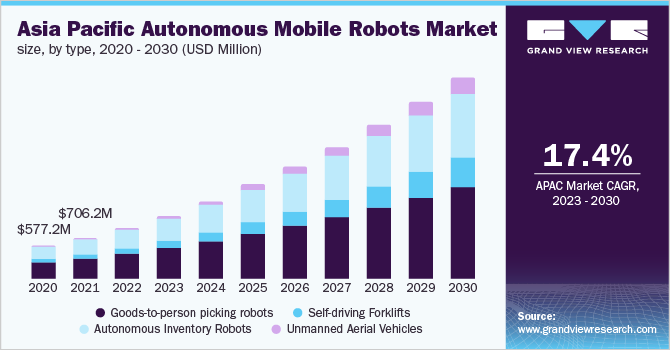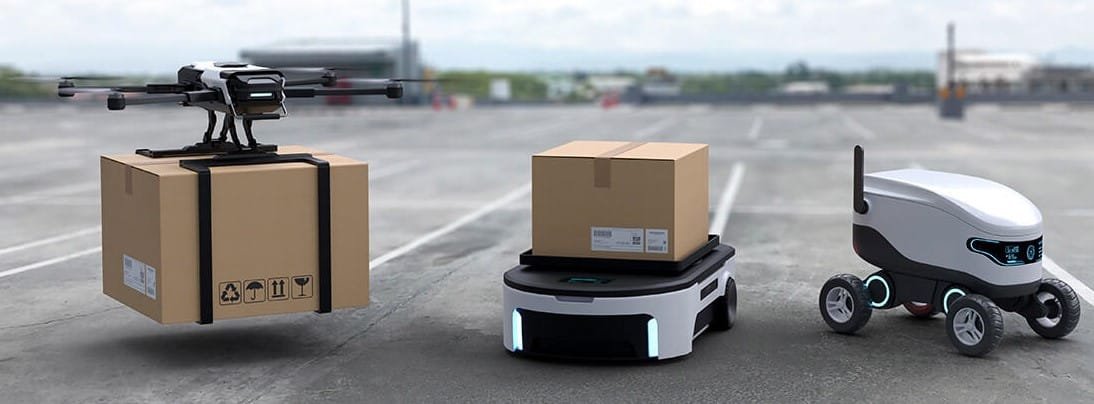The global autonomous mobile robots market size is expected to reach USD 9.56 billion by 2030 and is expected to expand at a CAGR of 15.5% from 2023 to 2030, according to a new report by Grand View Research, Inc. Autonomous mobile robots (AMRs) have triggered a paradigm shift in the way tasks, such as material picking, handling, and sorting, that are commonly associated with manufacturing and distribution are performed. These robots can ensure the reliable handling of raw materials and manufactured items within distribution and production facilities, thereby eliminating disruptions in operations.
Autonomous Mobile Robots Market Report Highlights
- The adoption of material handling automation solutions for inventory management is growing significantly across various industries
- The manufacturing segment dominated the market in 2022 and is expected to continue dominating the market over the forecast period
- Incumbents of the manufacturing industry have realized that the costs associated with the maintenance and procurement of autonomous mobile robots tend to be significantly less
Gain deeper insights on the market and receive your free copy with TOC now @: Autonomous Mobile Robots Market Report
Autonomous mobile robots (AMRs) are robotic systems capable of performing tasks and navigating in their environment without human intervention or continuous guidance. These robots are equipped with sensors, advanced algorithms, and artificial intelligence (AI) capabilities that enable them to perceive their surroundings, make decisions, and execute tasks autonomously. AMRs have a wide range of applications across various industries. In industrial settings, AMRs are utilized for material handling and logistics tasks. They can autonomously transport goods within warehouses, distribution centers, or manufacturing facilities, optimizing efficiency and reducing the need for manual labor. AMRs can navigate through dynamic environments, avoiding obstacles, and adapting to changing layouts, making them flexible and adaptable for different operational requirements. AMRs are also employed in healthcare settings. They can be used for tasks such as delivering medications, supplies, and equipment within hospitals or assisting in patient care activities. AMRs can navigate hallways, interact with elevators, and follow predefined paths, enhancing workflow efficiency and reducing the burden on healthcare staff.

Retail and e-commerce industries benefit from AMRs as well. These robots can assist with order picking, inventory management, and stock replenishment in warehouses or retail stores. By automating these processes, AMRs enable faster order fulfillment, reduce errors, and improve overall customer satisfaction. In the field of agriculture, AMRs are employed for tasks such as crop monitoring, planting, and harvesting. Equipped with sensors and AI algorithms, these robots can navigate through fields, identify ripe crops, and perform precise and efficient harvesting operations. AMRs in agriculture contribute to increased productivity, reduced labor costs, and optimized resource utilization. Furthermore, AMRs find applications in security and surveillance. They can patrol designated areas, monitor for intrusions, and provide real-time video feeds or sensor data to human operators. AMRs equipped with surveillance capabilities enhance safety and security in various environments, including industrial facilities, public spaces, and critical infrastructure.
Latest Developments In Autonomous Mobile Robots
The use of AI and machine learning algorithms is becoming increasingly prevalent in AMRs. These technologies enable robots to analyze and learn from vast amounts of data, improving their decision-making capabilities, adaptability, and autonomy. AI algorithms help AMRs optimize navigation, path planning, object recognition, and interaction with the environment. There is a growing trend towards collaborative robots or swarm robotics, where multiple AMRs work together to achieve complex tasks. These robots can share information, coordinate movements, and distribute workload, resulting in improved efficiency, scalability, and fault tolerance. Collaborative robots are particularly beneficial in large-scale warehouse operations and logistics. AMRs are becoming more mobile and flexible to adapt to different environments and tasks. They are designed to navigate a variety of terrains, including uneven surfaces, stairs, and narrow aisles. Modular and reconfigurable designs allow AMRs to be customized for specific applications, enabling quick adaptability to changing needs and environments.
The focus is shifting towards enabling smooth collaboration and interaction between AMRs and human workers. This involves developing intuitive user interfaces, natural language processing, and gesture recognition to facilitate seamless communication and cooperation between humans and robots. User-friendly interfaces and programming tools make it easier for non-experts to deploy and control AMRs. AMRs are increasingly leveraging cloud connectivity for data sharing, remote monitoring, and fleet management. Cloud-based platforms provide centralized control, data analytics, and fleet coordination, enabling efficient operation and optimization of AMR fleets. Data collected by AMRs can be analyzed to derive insights, improve performance, and enable predictive maintenance. As AMRs interact more closely with humans, safety measures and ethical considerations are gaining prominence. Advanced collision avoidance systems, emergency stop mechanisms, and human detection algorithms are being implemented to ensure safe human-robot interactions. There is also a focus on addressing ethical concerns related to privacy, security, and the impact of automation on employment.
Manufacturing and distribution facilities aggressively deploy material handling automation systems for tasks such as picking & packing, moving and sorting items. Incumbents of the transportation & logistics industry are leading the deployment of AMRs to boost production and distribution operations, in line with the increasing demand. With the fast-developing e-commerce business driving direct delivery trends, order fulfillment productivity has become a priority for warehouse operators.
AMRs benefit warehouse operators by reducing the workload for order pickers and improving safety by eliminating forklift accidents and musculoskeletal diseases. For instance, in December 2021, at the India Warehousing Show (IWS), Addverb Technologies Private Limited, a worldwide robotics business, announced the introduction of Veloce, a multi-carton picking mobile robot. The new picking robot boosts storage efficiency by increasing capacity and utilizing vertical spaces, enabling clients to save vital costs on warehouse space and associated pricey rentals.
The AMR market can be described as highly competitive, and robot manufacturers are pursuing various strategic initiatives to gain a competitive edge. North America region is expected to hold a significant market share of total global revenues, owing to the presence of leading providers of AGV and Autonomous Mobile Robots. European and Asian AMR manufacturers continue to increase their operations in the region.
Furthermore, increased government, private sector, and academic investments in innovation and R&D on developing technologies linked to surveillance robots are likely to enhance the market in the area. For instance, in January 2021, according to the senior manager of Universal Robots A/S’s strategic marketing and application development, companies of all sizes are figuring out a way to regain total production while maintaining social distancing alongside the class of robots that can work in any environment.
For More Details or Sample Copy please visit link @: https://www.grandviewresearch.com/industry-analysis/autonomous-mobile-robots-market/request/rs1
Autonomous Mobile Robots Market Insights By Region
Europe dominated the market with over 28% share of the global revenue. This can be attributed to the rising demand for material handling equipment from the incumbents of the manufacturing industry. Continued process automation in other sectors and industry verticals is also driving the regional market’s growth. The Asia Pacific regional market is anticipated to witness significant growth over the forecast period. The growing e-commerce industry in the emerging economies of Asia Pacific is promoting the deployment of autonomous mobile robots for inventory management. The adoption of AMRs is also gaining traction owing to the intense competition underway within the e-commerce industry as e-commerce companies try to distinguish themselves by reducing the delivery time of goods.
Competitive Analysis By Major Companies
Vendors in the AMR market focus aggressively on expanding their customer base and gaining a competitive edge over their rivals. Hence, they pursue various strategic initiatives, including partnerships, mergers & acquisitions, collaborations, and new product/ technology development. AMRs were used to work in progress pallets, transport raw material pallets, and finished goods pallets in place of forklifts. AMR is deployed in manufacturing and warehouse logistics operations to increase productivity, improve material monitoring, eliminate errors, and enable employees to focus on tasks that require complex human still stands are deployed in the manufacturing industry to minimize wasted movement and non-value-added activities such as efficiently moving raw materials, shift finished goods to its proper place by following a steady path or by enthusiastically creating routes to navigate varied environments. Some prominent players in the global autonomous mobile robots market include:
- ABB
- Bleum
- Boston Dynamics
- Clearpath Robotics, Inc.
- GreyOrange
- Harvest Automation
Grand View Research has segmented the global autonomous mobile robots market based on component, type, battery type, end-use, and region:
Research Methodology
We employ a comprehensive and iterative research methodology focused on minimizing deviance in order to provide the most accurate estimates and forecasts possible. We utilize a combination of bottom-up and top-down approaches for segmenting and estimating quantitative aspects of the market. Data is continuously filtered to ensure that only validated and authenticated sources are considered. In addition, data is also mined from a host of reports in our repository, as well as a number of reputed paid databases. Our market estimates and forecasts are derived through simulation models. A unique model is created and customized for each study. Gathered information for market dynamics, technology landscape, application development, and pricing trends are fed into the model and analyzed simultaneously.
For Customized reports or Special Pricing please visit @: https://www.grandviewresearch.com/checkout/select-license/autonomous-mobile-robots-market
About Grand View Research
Grand View Research provides syndicated as well as customized research reports and consulting services on 46 industries across 25 major countries worldwide. This U.S. based market research and consulting company is registered in California and headquartered in San Francisco. Comprising over 425 analysts and consultants, the company adds 1200+ market research reports to its extensive database each year. Supported by an interactive market intelligence platform, the team at Grand View Research guides Fortune 500 companies and prominent academic institutes in comprehending the global and regional business environment and carefully identifying future opportunities.
Contact:
Grand View Research, Inc.
Phone: 1-415-349-0058
Toll-Free: 1-888-202-9519
Email: sales@grandviewresearch.com
Web: https://www.grandviewresearch.com

